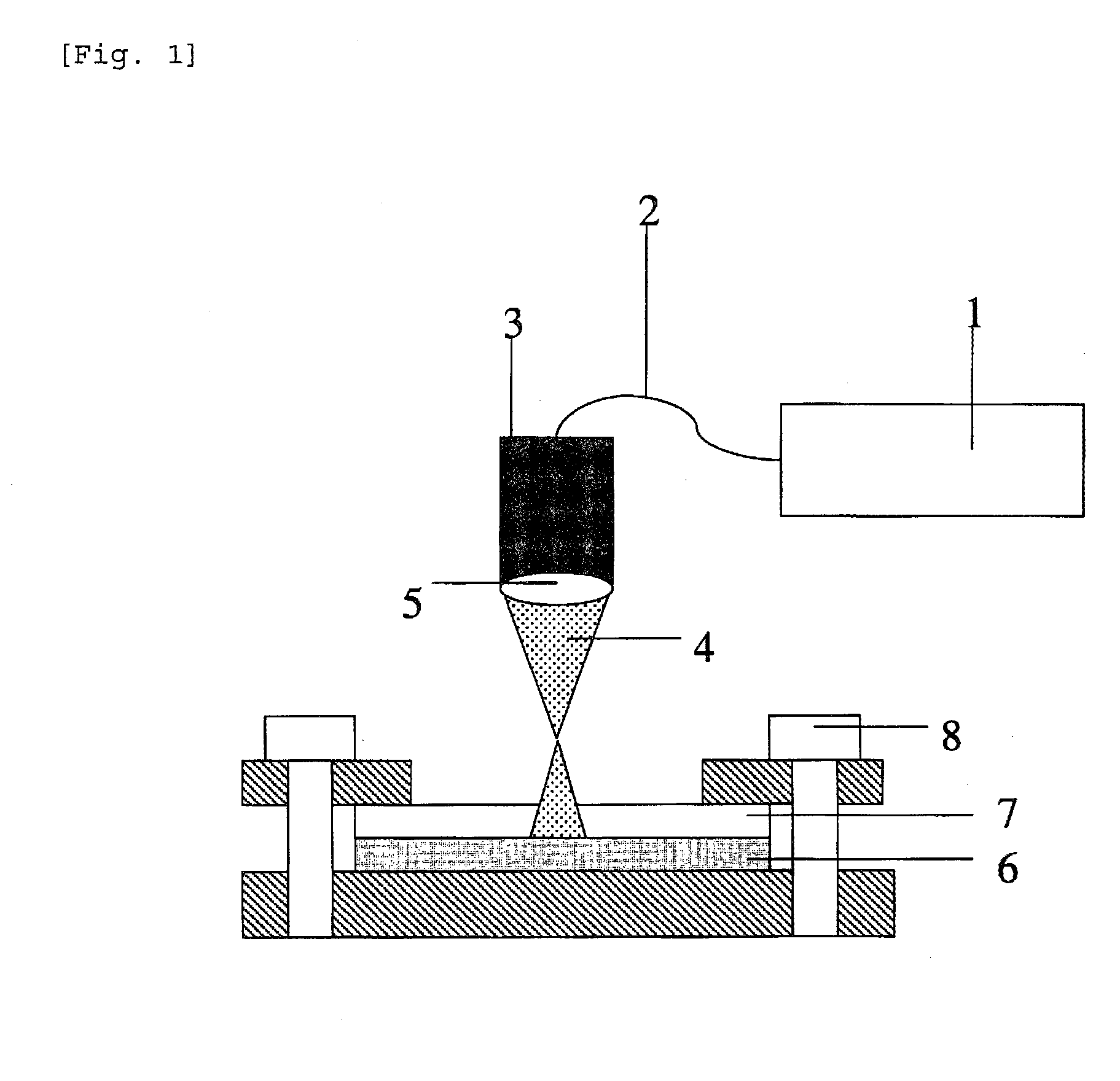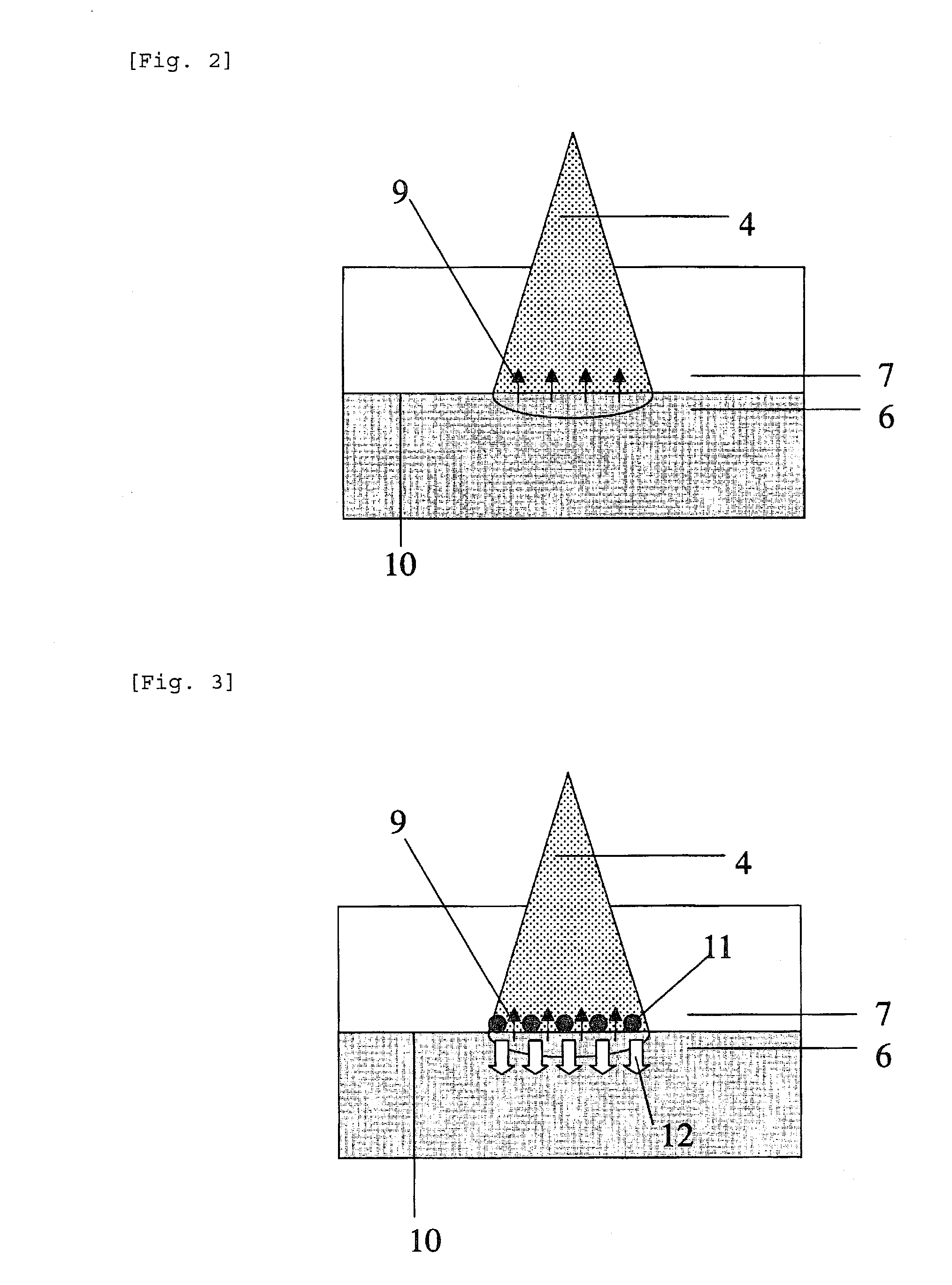Method for metal-resin joining and a metal-resin composite, a method for glass-resin joining and a glass-resin composite, and a method for ceramic-resin joining and a ceramic-resin composite
a metal-resin and composite technology, applied in the field of metal-resin joining and metal-resin composites, can solve the problems of limited application, reduced production tact, and inability to achieve precise and precise joining, and achieve the effect of small joint and precise and fine jointing
- Summary
- Abstract
- Description
- Claims
- Application Information
AI Technical Summary
Benefits of technology
Problems solved by technology
Method used
Image
Examples
example 1
[0100]Hereinafter, Examples of the present invention are described with reference to the drawings.
[0101]FIG. 1 is a view that shows the constitution of the method for a metal-resin joining of Example 1. As shown in FIG. 1, fiber laser light 4 having a wavelength of 1090 nm was introduced to a laser processing head 3 from a fiber laser oscillator 1 via a fiber 2 and focused by a light focus lens 5 having a focal point distance of 80 mm. At the position 15 mm away from the position in the focal point in the direction away from the lens, a metallic material which is a workpiece 6 (pure titanium), and a resin material which is a workpiece 7 (polycarbonate, “Novaflex 7025IR” manufactured by Mitsubishi Engineering-Plastics Corporation, glass transition temperature=150° C. (Tmg compliant with the DSC method JIS K 7121), loading deflection temperature under loading of catalogue value=129° C. (loading: 1.80 MPa) / 142° C. (loading: 0.45 MPa), compliant with ISO 75-1, 75-2) were superposed each...
example 2
[0102]FIG. 6 is a view that shows the constitution of the method for a metal-resin joining of Example 2. As shown in FIG. 6, YAG laser light 17 having a wavelength of 1064 nm was introduced to a laser processing head 16 from a YAG laser oscillator 15 via a fiber 2 and focused by a light focus lens 18 having a focal point distance of 200 mm. At the position 30 mm away from the position in the focal point in the direction away from the lens, a metallic material which is a workpiece 19 (stainless steel SUS 304), and a resin material which is a workpiece 20 (PA12 amorphous polyamide, “T-714H” manufactured by Toyobo Co., Ltd., glass transition temperature=160° C. (Tmg compliant with the DSC method JIS K 7121), loading deflection temperature under loading=130° C. (loading: 1.80 MPa) / 145° C. (loading: 0.45 MPa), compliant with ISO 75-1, 75-2) were superposed each other and fixed by a clamp 8, and traveled at the traveling speed of 30 mm / s during irradiation of the laser light having the po...
example 3
[0103]The portion to be joined of the metallic material and the resin material was heated in a method similar to that of Example 1 under the following conditions. The surface appearance and state of the bubbles at the joint were observed while changing laser power, and the tensile shear loading and the tensile shear strength of the joint were also measured.
[0104]Metallic material: stainless steel SUS 304 plate (thickness: 2 mm)
[0105]Resin material: PA12 amorphous polyamide plate (“T-714H” manufactured by Toyobo Co., Ltd.) (thickness: 2 mm)
[0106]Material at heating source side: resin material
[0107]Heating source: YAG laser[0108]Power (changed between 0 to 1000 W)[0109]Defocusing distance: 20 mm (beam diameter: 5 mm)[0110]Traveling speed: 10 mm / s
[0111]The surface appearance (power: 110 W, 300 W, 560 W and 850 W) of the joint when the laser power was changed is shown in FIG. 11. As is apparent from FIG. 11, the bubbles of the resin material began to generate at the laser power of 110 W...
PUM
| Property | Measurement | Unit |
|---|---|---|
| tensile shear strength | aaaaa | aaaaa |
| diameter | aaaaa | aaaaa |
| diameter | aaaaa | aaaaa |
Abstract
Description
Claims
Application Information
 Login to View More
Login to View More - R&D
- Intellectual Property
- Life Sciences
- Materials
- Tech Scout
- Unparalleled Data Quality
- Higher Quality Content
- 60% Fewer Hallucinations
Browse by: Latest US Patents, China's latest patents, Technical Efficacy Thesaurus, Application Domain, Technology Topic, Popular Technical Reports.
© 2025 PatSnap. All rights reserved.Legal|Privacy policy|Modern Slavery Act Transparency Statement|Sitemap|About US| Contact US: help@patsnap.com



